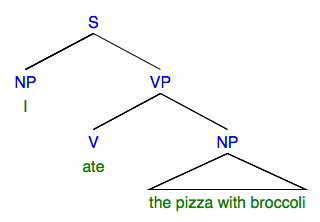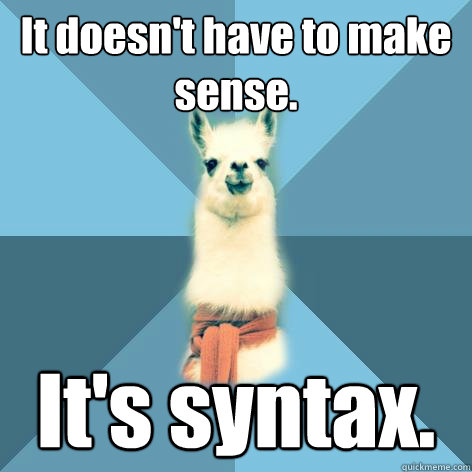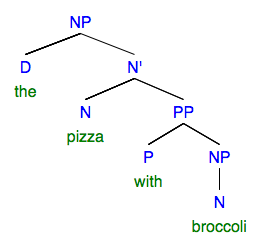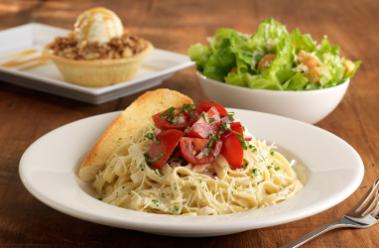Module 3: Word and Phrase Categories
Module 3: Advanced Unit
WORD AND PHRASE CATEGORIES
Contents of Advanced Unit:
- More on phrases as functional units
- Phrase structure rules
- Test Yourself: Quiz for Module 3, Advanced Unit
1. More on phrases as functional units
One of the ways I gave you to think about phrases was as functional units within a sentence—or within another phrase that is smaller than a sentence. A phrase is a unit of meaning that serves some purpose relative to other units of meaning. I want to revisit and expand on this idea, now connecting the notion of phrases as functional units to the notion of them as structural units—elements that have a smaller structure and that are part of a larger structure.
It’s been a while since we saw a phrase structure tree. Consider this one from Module 1:

This sentence starts with a subject, the pronoun I. Subject is one function that phrases can play within a sentence. A subject is the topic—the unit you are saying something about.
Then we have a verb, ate, and an NP, the pizza with broccoli. How would you characterize the function of the pizza with broccoli? You might say, “it’s the thing being eaten” or “it’s what’s having the action of eating done to it.” In technical terms, it is the object of the verb ate. Object is another function phrases can play—this time, within the verb phrase. Since the NP [the pizza with broccoli] lies beneath the level of the VP in the sentence, we say that its function is one within the VP. Its relationship is directly to ate, not to I. This is one advantage of phrase structure trees: they clearly indicate the locality of phrasal relationships.
Now, what is the function of the VP? It tells us something about the subject. Consider the following verb phrases:
is delicious
contained broccoli
was eaten quickly
Each of these VPs can be used to say something about any number of subjects–the same one:
The pizza is delicious
The pizza contained broccoli.
The pizza was eaten quickly.
or different ones:
The pizza is delicious.
My salad contained broccoli.
Our dessert was eaten quickly.
In more technical terminology, the components of a verb phrase predicate something of the subject. Much more on this in Module 7.
Note that the same NP could fulfill either the subject or object function—even in the same sentence!
This doesn’t make much sense, but it is grammatical!

Can you identify the subject and object NPs in each of the following?
The pizza was delicious.
I ate the pizza.
Ugly ducklings swim quickly.
I love ugly ducklings.
My coffee cup is empty.
I should fill my coffee cup.
Back to I ate the pizza with broccoli. Let’s look inside that VP, specifically inside the NP, the pizza with broccoli.

We have four different words. If we break it down into its internal structure, we have this tree:

What happened?! We went from a simple NP to an NP with a PP and NP, plus some weird N’ thing, inside of it! Ack!
Don’t panic. This is just another example of how language is structured hierarchically, as units within units. Sentences contain phrases, but phrases ALSO can contain other phrases.

Start reading the tree from the bottom. What is the function of broccoli? It is the object of the preposition with, which connects broccoli to pizza in a way that means, roughly, “broccoli on pizza.” The PP [with broccoli] functions as a modifier of the noun pizza. It could modify a different noun, like salad; it could also modify a verb, like ate. In each case it is serving a modification function: it is not grammatically necessary, but adding information.
So we have already built up to [pizza with broccoli]. I have labeled this as an N’ level in the tree. Pronounce this “N-bar” and anytime you see the ‘ notation, think to yourself, “bar.” This notation is borrowed from theoretical syntax. A bar-level says, basically, “I’m a phrase in progress. There is more to me, so don’t close me off yet!” (There’s a joke in here somewhere, about a bar telling you not to cut it off…)
Think about it: [pizza with broccoli] is more than just a noun; it’s a noun plus a PP modifier. And it could be a complete noun phrase, without the determiner the. It could function as an subject, or as an object:
Pizza with broccoli is delicious.
I love pizza with broccoli.
Yet, we know that NPs often do have determiners in them, and in this case our NP does have a determiner. Our N’ level lets us show that [pizza with broccoli] is a unit, whose reference is being specified/restricted by the addition of the determiner the. [the pizza with broccoli] is a larger unit than [pizza with broccoli]. But importantly, they both have the properties of a noun phrase—that’s why we label [pizza with broccoli] as N’ rather than just ‘ or some other kind of phrase.
Hopefully you can start to see why the parts of [the broccoli with pizza] are labeled as they are in the tree.
There may be one part of the tree that still seems funky. Why is broccoli considered to be a whole NP, when it only consists of one word? This was also the case with the subject I in the original sentence:

Why is I labeled as an NP, when it is just one word? This brings us back to phrases as functional units. First let’s consider the function of object of preposition. Check out all of the prepositional phrases below:
with broccoli
with some anchovies
with a five-cheese blend
There are three different units functioning as object of preposition:
broccoli
some anchovies
a five-cheese blend
You would probably have no problem identifying [some anchovies] and [a five-cheese blend] as noun phrases, since they each contain a clear noun head, anchovies and blend. What about [broccoli]? It is also a noun phrase! To understand how one word can be a noun phrase, we are going to need to introduce a more formal way of thinking about grammatical rules.
Let’s say that we wanted to describe the structure of prepositional phrases in English using a mathematical-type rule. Here are those three PPs again:
with broccoli
with some anchovies
with a five-cheese blend
If we wrote a rule based just on the words we see in each individual PP, we would actually need three different rules:
PP = P + N
PP = P + D + N
PP = P + D + Adj + N
Each of these rules says “Prepositional Phrase equals ….” In the first, it’s the combination of a preposition and a noun. In the second, a preposition, determiner, and noun. Etc.
We can imagine an infinite number of such rules being possible! All of the PPs below would have yet different (and longer) rules:
for your favorite pizza that contains broccoli
for the pizza you got from the store down the street
for the pizza with the cheese from Italy which the magazine rated #1
Rules specific to each phrase we actually find in English are not useful for the purpose of understanding the abstract patterns of English. Imagine if we had to write an individual rule in order to understand each English sentence! What are we even doing here?!
Rather, we want descriptive economy: to be able to describe the maximum possible number of sentences with the least possible number of rules/patterns/structures. Thinking about function at the phrase level—rather than the word level—is one way we accomplish descriptive economy.
So, if I consider object of preposition to be a function served by NPs, I can account for all three of my seemingly-different PPs below:
with broccoli
with some anchovies
with a five-cheese blend
with just one rule:
The question then is only what is possible as part of an NP. We know that an NP has to have a head, which is a noun. Additionally, we know that NPs can have modifiers, such as adjectives; and, we know that NPs can have determiners. But an NP that consists only of a noun is no less good as an object of a preposition than a more complex NP with other stuff in it. One word or ten; if it’s the object of a preposition, it’s an NP.
Consider another function of NPs we’ve seen: subject. Back to our sentence.

I called I an NP. I is just a pronoun, but it has noun properties, and critically, it functions just like any other NP, in the subject position:
I ate the pizza
The students ate the pizza
All the faculty members ate the pizza
Everybody who was in Denney Hall ate the pizza
Again, calling all of these subjects NPs recognizes that a) they all have noun-like qualities, and b) they all function in the noun-like role of subject. I don’t have to account for every single possible NP as a possible subject; I just say “Subjects are usually NPs.” And then we can talk about what all can be in an NP. Neat, huh?
Here’s an analogy I like to use. Imagine a three-course meal in a typical “American” restaurant. What do you call the three courses?

The “appetizer, entrée, dessert” lineup is standard in many restaurants and in some traditions of American home cooking. Now, consider that you have a choice between the following two menus:
| Menu A | Menu B | |
| Appetizer | cheese and bread | grilled shrimp |
| Entrée | linguine with red sauce and clams and broccoli | steak and asparagus |
| Dessert | chocolate cake and raspberries | vanilla ice cream |
Menu A has an appetizer consisting of two items, while Menu B’s appetizer contains just one. Menu A has an entrée with three items, while Menu B has an entrée with two items. And dessert is two items on Menu A, but just one item on Menu B.
When a course only has one item, you don’t say “that’s no longer an appetizer!” or “hey, ice cream isn’t dessert unless it has apple pie with it!” You still consider shrimp a possible appetizer and ice cream a possible dessert, because they are serving those functions within the meal. Compare to phrases completing the functions in two different sentences:
Sentence A Sentence B
NP-subject the committed students they
verb read read
NP-object the too-long chapter it
Sentence A has a 3-word subject and a three-word object. In Sentence B, these functions are served by single-word entities. But they are all phrases; phrases serve functions.
To sum up, here are the important takeaways:
- A phrase serves a function in a larger phrase (or a sentence)
- A phrase may be instantiated by an infinite number of word combinations
- Every phrase has a head
- A phrase can consist solely of its head, therefore…
- A single word can be a phrase
3. Test Yourself: Quiz for Module 3, Advanced Unit
Complete this before moving on to the next unit!